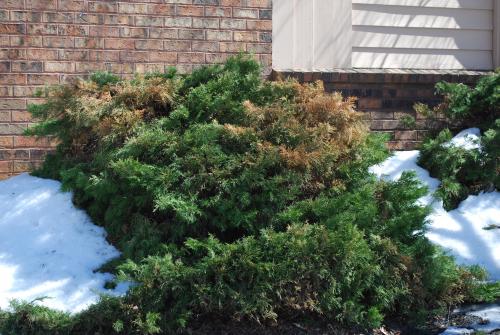Tree, turf and ornamental plant update — May 11, 2018
Winter injury on many different plants is visible, and gypsy moth, white pine weevil adults, ticks, stink bugs and boxelder bugs are active.

The following is a summary of current plant development and pest activity for landscape professionals, Master Gardeners, nursery and Christmas tree growers.
The recent warm weather has resulted in an explosion of plant growth and activity. Trees are budding, and forsythia and dandelions are in bloom.
Winter injury continues to show up on many different plants and perennials. Typically, we see winter injury occurring in late winter or early spring when temperatures warm up and then take a dip. This year, we believe the warm and dry fall may have delayed hardening of many trees and shrubs. In the middle to late December, we saw temperatures take a steep decline going below zero in many locations. In addition, plant stress was compounded in areas that went into winter with very dry soils.
Growers and homeowners are reporting damage on many conifers, woody ornamentals and perennials including Japanese maple, Macrophylla hydrangea (flower damage), arborvitae, Dwarf Alberta spruce, Douglas-fir, white pine, Fraser, Canaan and Concolor firs. Damage can be just needle or leaf browning to complete plant death.
Winter injury to Juniper.
Gypsy moths have hatched in southern Michigan and we are seeing high gypsy moth numbers in many areas. Gypsy moth caterpillars can defoliate trees, and during large outbreaks, debris and frass from feeding caterpillars can limit outdoor activities. For more information on gypsy moth, see “Growing populations of gypsy moth caterpillars raise concern for landscapes and woodlots” by Bob Bricault, Michigan State University Extension.
White pine weevil adults were found emerging last week from protected and insulated litter (fallen needles) under trees. These weevils move up to the tops of the trees in late afternoon or early evening and feed on the terminal leader and lay eggs. For more information, see “Control white pine weevil in early spring” by Dave Smitley, MSU Entomology.
People are still battling overwintering populations of stink bugs and boxelder bugs in and around their homes. These troublesome insects should be moving away from homes and structures over the next week or so.
There is no reason to expect fewer ticks this year. In fact, it is likely there will be more ticks in areas where they were encountered last year and they will show up in areas where they had not been encountered previously.
The American dog tick and the deer tick (blacklegged tick) are active right now, so be prepared with your tick repellents and tweezers. The Michigan Department of Health and Human Services has posted their Michigan Lyme Disease Risk Map for 2018. For more information on controlling and identifying ticks, see these past MSU Extension articles:



 Print
Print Email
Email




